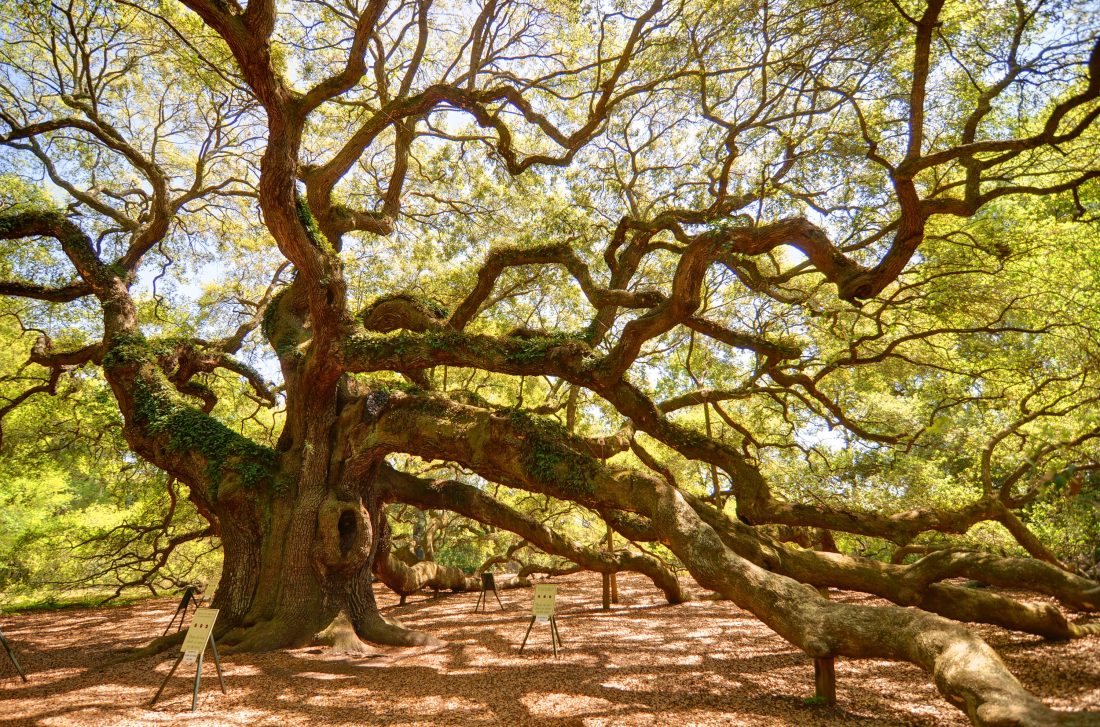“To exist as a nation, to prosper as a state, and to live as a people, we must have trees.”
In 1872, twenty-nine years before fierce conservationist Teddy Roosevelt voiced a rallying cry for National Arbor Day, a small Nebraska pioneer town held the country’s first tree-centric celebration. Nowadays, every year on the last Friday of April, the U.S. holds its National Arbor Day, a celebration of planting, caring for, and paying respect to trees in every corner of the country. Here in the South, where a good book, a chilly glass of sweet tea, and the shade of an old oak are warm-weather staples, we have a special appreciation for trees—and many trees worth celebrating.
Angel Oak
Johns Island, South Carolina
Some experts believe the Angel Oak, located twenty minutes from downtown Charleston, took root on Johns Island between 400 and 500 years ago, although local lore places the date even further back—1,500 years, which would make this live oak one of the oldest living things east of the Mississippi. Regardless of the tree’s true age, it’s an impressive sight, with a trunk measuring 28 feet in circumference and a limb-span covering 17,000 square feet.

Andrew Johnson Willows
Greeneville, Tennessee
The draping willows on the estate of the seventeenth president of the United States started as cuttings from trees growing around the solitary South Atlantic St. Helena Island tomb of French conqueror Napoleon Bonaparte. More than 100 years later, the original willows guarding Napoleon’s tomb died, but their Tennessee descendants were still standing. In 2000, the National Park Service mailed slips of Johnson’s willows to St. Helena, where they were planted and have grown steadily since.

The Big Tree
Lamar, Texas
Only a few homes, a chapel, and this live oak stood after Lamar, Texas, was bombarded by federal troops during the Civil War. Plunged deep into the sandy coastal soil, the Big Tree at Goose Island State Park continues to grow after for more than an estimated 1,000 years of life, surviving at least 40 hurricanes and innumerable floods, wildfires, and droughts.

Brooklyn Magnolia
Brooklyn, New York
How did the most Southern of trees come to find a northern home? In 1885, William Lemken, a North Carolinian living in New York, brought seedlings from his home state to the Big Apple and planted them in his front yard on 679 Lafayette Avenue. The Magnolia grandiflora is genetically coded for warm, not-too-windy climates. Against geographic odds, one of Lemken’s took root and became a landmark. Horticulturalists credit the microclimate created by the tree’s unique position between buildings that block cold winds and provide warmth from their cellars.

(Photograph by Jim Henderson)
The Dueling Oak
New Orleans, Louisiana
Upon seeing the Mississippi River, a European scientist living in New Orleans jeered, “[it’s] but a tiny rill compared to the great rivers of Europe.” Upon hearing this, a Creole man, not one to take insult so lightly, challenged the scientist to a duel under a pair of live oaks in the South end of City Park. Those two oaks, later named the Dueling Oaks, served as the field for many an affaire d’honneur between the city’s founding and when dueling was officially outlawed in 1890. Today, only one of the pair remains standing, its partner a victim of a hurricane in the 1940s. The remaining oak, now 300 or more years old, sits on the corner where Dueling Oaks and Dreyfous Drive meet.

Eisenhower Tree
Augusta National Golf Course, Georgia
Tradition at Augusta National rarely wavers—even for presidents. Dwight D. Eisenhower, who visited the course twenty-nine times while in office, had had enough of a 65-foot-tall loblolly pine guarding the green on 17, so he lobbied Augusta’s Board of Directors for its removal. His pleas were ignored, and the tree stood until 2014, when an ice storm damaged it beyond repair and forced its removal. Today, a cross section of the tree is displayed at the Eisenhower Presidential Library in Abilene, Kansas.

The Eisenhower Tree in 2011. (Photograph by Shannon McGee)
Emancipation Oak
Hampton, Virginia
After Union forces took Fort Monroe during the Civil War, the area and the surrounding town of Hampton became host to asylum-seeking slaves. Their number grew so quickly that the American Missionary Association hired Mary S. Peake, a born-free black Virginian, to teach the children of the freedmen and women, with only the shade of a live oak as her classroom. Peake taught through the day, and later began teaching the parents of the children at night, all of which was previously outlawed in Virginia. In 1863, Peake and Hampton’s black community gathered under the tree’s branches for the first Southern reading of the Emancipation Proclamation, giving birth to the tree’s name.

(Photograph by Esther Westervel)
The Survivor Tree
Oklahoma City, Oklahoma
Before the morning of April 19, 1995, the American elm across from the Murrah Building provided shade from the hot Central Plains sun. But then, the horrific bombing stripped it of most of its bark, limbs, and branches. Nearly a year later, at a memorial ceremony, attendees noticed the tree was blooming again and, now it’s a hallmark of the Oklahoma City National Memorial. Every year on the anniversary of the tragedy, volunteers distribute its seeds and seedlings to visitors upon request.

(Photograph by Dustin M. Ramsey)
The Treaty Oak
Jacksonville, Florida
The name “Treaty Oak” harkens back to a time when settlers and native Floridians signed a peace treaty under the Jacksonville landmark, allowing European settlers and natives to live without conflict. Or at least that’s what Pat Moran would’ve had you think. With the sprawling live oak in danger from land development in the 1930s, Moran, a reporter for the Florida Times-Union, concocted an apocryphal origin story that he published in the newspaper, with hopes that the tree might be spared. It was, and today its limbs and branches give shade in Jesse Ball duPont Park on the St. Johns River.

(Photograph by James Willamor)
The Tree That Owns Itself
Athens, Georgia
Now barely legible, a plaque planted in front of a white oak, reads:
“For and in consideration of the great love I bear this tree and the great desire I have for its protection for all time, I convey entire possession of itself and all land within eight feet of the tree on all sides.”—William H. Jackson
W.H. Jackson, a professor at the University of Georgia and son of James Jackson, a Georgia governor and senator, deeded the tree to itself sometime between 1820 and 1832, so that no person or development would have legal right to remove it. Naturally, there are many reasons why it is legally impossible for a tree to own itself, foremost being the recipient of property must be aware they are receiving said property. But in effect the deed worked, and the tree stood in the right of way on the corner of South Finley and Dearing Streets in Athens until 1942, when it fell. Four years later, the University of Georgia’s Department of Horticulture and Athens’s Garden Club planted a sapling, grown from an acorn from the original tree, in its exact location. Named the Son of the Tree That Owns Itself, it is now cared for by the surrounding community, municipal government, and Athens’s Junior Ladies Garden Club. (Read more about the tree here.)









